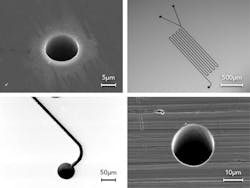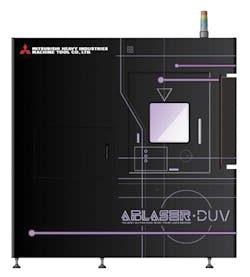Method achieves 10μm-diameter drilled holes
YUJI IMAMIYA, SATORU AKAMA, YOSHIHITO FUJITA, and HARUHIKO NIITANI
In recent years, a microfabrication method utilizing a short-pulse, short-wavelength laser has attracted attention in connection with the growing demand for further miniaturization and increased quality of ultraprecision machining. Using a picosecond-pulse laser enables ablation with no thermal effects, achieving high-precision fabrication with superior quality. Additionally, using a short-wavelength laser can make the spot diameter of a laser beam smaller, enabling finer fabrication.
Currently, popular short-pulse lasers for microfabrication include green lasers (532nm), followed by ultraviolet (UV) lasers (355nm). On the other hand, deep-ultraviolet (DUV) lasers at 266nm have not been widely used because of difficulties in handling.
At Mitsubishi Heavy Industries Machine Tool, we have developed a helical drilling system that employs a DUV laser. With it, we conducted hole-drilling tests in which we achieved 10μm-diameter hole drilling with an aspect ratio of 10. Moreover, because of the high photon energy of the DUV laser, high-quality hole drilling was accomplished on a workpiece material on which precision machining and fabrication based on chemical actions are extremely difficult. This occurs because of its high degree of hardness and chemical stability.
DUV laser focusing system
In laser microfabrication, a laser beam is focused and irradiated on the surface of the target workpiece, and the irradiated part of the workpiece is removed by the photon energy. When the focused laser spot diameter is smaller, the area removed by laser irradiation also gets smaller, increasing the microfabrication quality. There are multiple means to achieve a smaller focused laser spot diameter, such as utilizing a short-wavelength laser, enlarging the beam diameter before focusing, and shortening the focal length.
However, when the wavelength of the laser light reaches the UV range, the laser's absorbance through glass materials increases. Therefore, it is necessary to ease the strain on optical element materials such as the lens. In other methods, the convergence angle is large, which is likely to cause a gap in size of the hole between its entrance and exit and to reduce the focal depth, limiting the shape of the hole created by drilling.
A newly developed optical laser focusing system was adopted for the DUV laser. The durability of the lens was ensured by testing the durability against the DUV laser beam of the glass used for the optical element beforehand, while selecting the optimal glass material and setting appropriate laser irradiation intensity. Furthermore, by optimizing the focal length and lens form, the convergence angle is minimized and a long focal depth is achieved, while the focused laser spot diameter remains very small.
Experimental ablation rates
Ablation rates of a DUV laser beam and a green laser beam (515nm) with various different materials were made to compare and evaluate their characteristics (FIGURE 1). A single-crystal silicon carbide (SiC) wafer, borosilicate glass, and stainless steel were prepared as workpieces. These materials were individually irradiated with a focused DUV or green laser beam by one pulse only (FIGURE 2).
Subsequently, the maximum depth of the hole made by irradiation was measured. Ablation rates for each material were obtained by conducting irradiation and measurement with different levels of pulse energy. The vertical axis of the chart in FIGURE 1 indicates the fabrication depth, while the horizontal axis represents the energy intensity at the central part of the irradiated laser beam.
When ablation rates were compared between the DUV and green laser beams, those of the DUV laser beam were higher in every material. The DUV laser beam also achieved a higher ablation rate for the SiC material, which has a large bandgap. Generally, when inducing ablation by a short-pulse laser, the photon energy of the laser beam must be higher than the bandgap of the workpiece material.
Since photon energy is in inverse proportion to laser wavelength, the photon energy of the DUV laser beam is about two times higher when compared to the green laser, and exceeds the bandgap of the SiC material. Therefore, the ablation phenomena on the SiC material can be fully induced by the DUV laser beam. With the DUV laser, a high ablation rate for the borosilicate glass was obtained. Accordingly, it is assumed that the photon energy of the DUV laser beam contributed largely to this high ablation rate.
The above results verified the superiority of the DUV laser to the green laser beam, and also made it possible to estimate the optimum pulse number needed to obtain the fabrication depth required for individual materials. Thus, higher drilling quality and optimized drilling rates are obtained.
Helical drilling features
Percussion drilling, widely used for micro-drilling, is a method to drill holes by irradiating a pulsed laser beam in a fixed place without allowing the beam to move or rotate. Therefore, since the laser spot profile is directly transcribed on workpieces, it is difficult to drill holes with high accuracy.
Alternately, a helical drilling method has been used in the hole-drilling test described previously. Helical drilling is carried out while precisely rotating the path of the laser beam at a high speed, which enables drilling with high roundness and quality. In addition, an optical head we developed allows the control of the incidence angle as well as the rotation diameter of the laser beam, which can achieve any hole diameter and cross-sectional shape.
Microfabrication examples
Using the drilling characteristics obtained from the one pulse irradiation test described above, laser irradiation conditions were determined, based on which hole-drilling was performed on a stainless steel (SUS304, thickness: 0.2mm) and single-crystal SiC wafer (thickness: 0.1mm). In addition, micro-grooving was performed on a borosilicate glass (thickness: 0.7mm).
FIGURE 3 shows samples of the hole-drilling and micro-grooving. The roundness of both holes was excellent, which indicates that drilling with high form accuracy was achieved by the helical drilling method. Further, the inner surfaces of the holes and the groove were smooth and free from re-melted matter, proving that ablation with reduced thermal effects was achieved not only on the stainless steel, but also on the SiC wafer and borosilicate glass.
By using the DUV laser beam and optimized optical system and precisely controlling the beam trajectory, we achieved high-quality, 10μm-diameter drilled holes with an aspect ratio of 10 and 10μm-wide and deep micro-grooving, which conventionally had been very hard to accomplish.
Outlook
To satisfy the need for finer laser microfabrication, we developed an optical system that uses a short-pulse DUV laser, with which drilling characteristics of various different materials were identified. In addition, a microfabrication test with a DUV laser and a helical drilling method was conducted that achieved ultrafine hole-drilling of a minimum of 10μm in diameter and an aspect ratio of a maximum of 10.
This laser optical system is installed in the ABLASER-DUV laser microfabrication system (FIGURE 4). We plan to continue technical development so that we will be able to offer optimal solutions to satisfy the need for finer microfabrication with higher quality in various industrial fields.
REFERENCES
1. K. Nakagawa et al., "Microdrilling technology using short pulsed-laser," Mitsubishi Heavy Industries Technical Review, 52, 3 (2015).
2. Y. Imamiya et al., "Development of microfabrication technology using DUV laser," Mitsubishi Heavy Industries Technical Review, 53, 4 (2016).
3. See https://goo.gl/fchdjw.
4. See https://goo.gl/HGRXit.
YUJI IMAMIYA,SATORU AKAMA,YOSHIHITO FUJITA, and HARUHIKO NIITANI are with the Advanced Manufacturing System Development Center at Mitsubishi Heavy Industries Machine Tool, Shiga, Japan; www.mhi-machinetool.com.



